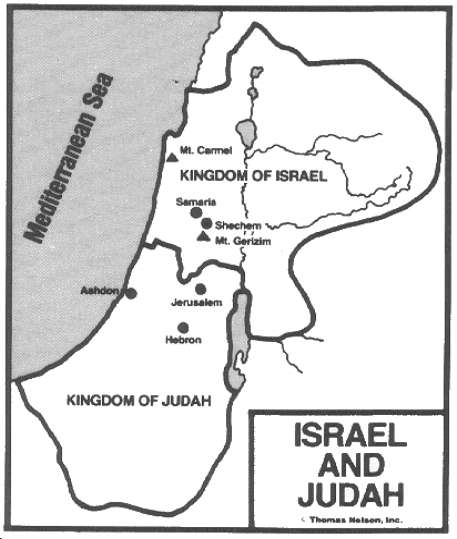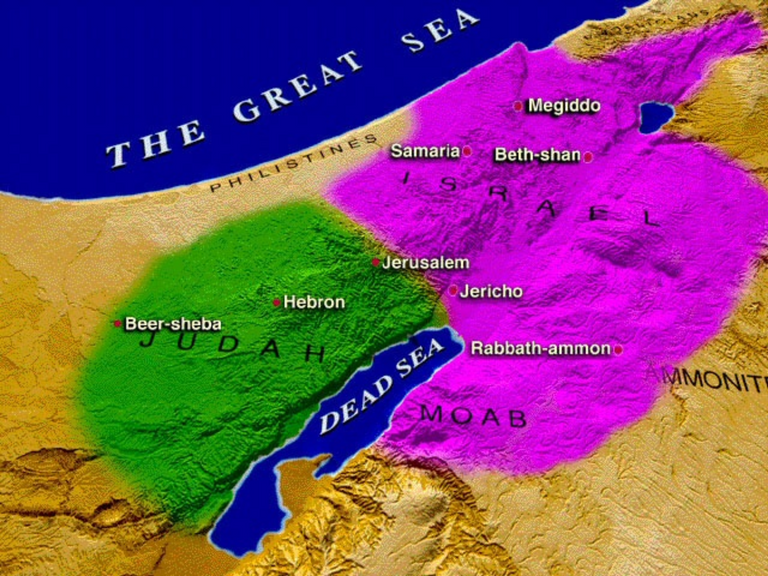With an initial chronology of the kings proposed in Part 3, the next step is to establish a date we know we can depend on. Since the date of the division of the kingdom is not readily available to us, the earliest verifiable date must be attained. This is found by researching Assyrian history. There is much to this research that can’t be dealt with here, but Thiele shares some valuable information that reveals that Ahab’s reign must have ended 853, and Jehu’s must have begun in 841.
Ahab is listed by Shalmaneser III as one of the kings of the Westland who fought against him in the battle of Qarqar [which] was fought in the year 853… Shalmaneser also mentions that he received tribute from Jehu during his expedition to the west in his eighteenth year. This would be in the eponymy of Adad-rimani (841). Thus Jehu was already reigning over Israel sometime in 841… Ahab could not have reigned beyond 853 and Jehu could not have begun to reign before 841, because the interval between the death of Ahab and the accession of Jehu is exactly twelve years, being made up of the reigns of Ahaziah, the son and successor of Ahab, and Joram, who was slain and succeeded by Jehu… Since the interval between the battle of Qarqar, at which Ahab fought in 853, and the time when Jehu paid tribute to Shalmaneser in 841 is also a period of just twelve years, it is in this period that the reigns of Ahaziah and Joram must have taken place, with 853 as the last year of Ahab and 841 for Jehu’s succession. [1]

The Black Obelisk depicts Jehu bowing before Shalmaneser III
By Steven G. Johnson (Own work), CC BY-SA 3.0
Having established these dates, and knowing that Athaliah, Ahaziah’s mother, began to rule the same year as Jehu, we are able to work out from 841. This also affirms the non-accession-year system in Israel during this time period. Using this information we are able to add the reigns of all the kings of Israel up to and including Ahab, minus their accession years. By subtracting (in a sense adding because it is B.C) 78 years to 853, Ahab’s last year, we arrive at the date of 931 or 930 B.C.
 [2]
[2]Other dates can be known through Assyrian historical accounts. For instance, Assyrian history records that Sennacherib went on his third campaign against Aram, “and shut up ‘Hezekiah the Jew… like a caged bird in Jerusalem, his royal city.’” This event is recorded in 2 Kings 18:13 as happening in the fourteenth year of King Hezekiah.a According to the Assyrian historical record this took place in 701.[3] From this date we can discern the dates of all the kings from the division of the kingdom in 931 to the Babylonian captivity in 586.
NOTE: The final Table is found at the bottom of this article, for reference. From here on you will see some superscript referencesxx (like the one next to Hezekiah above) that refer to certain data in the final results. This is necessary for those who want to dig further.
Having set a reasonable date for the division of the kingdom we will work from 930 because it is easier to work from and it is also difficult, in light of varying calendars, to discern whether the actual year of the division of the kingdom was 930 or 931. The format used here will follow closely that used by Thiele in The Mysterious Numbers of the Hebrew Kings (pp 80 ff.). In most, if not all, cases the biblical reference can be found in the chart.

Rehoboam ruled from 930-913 (17 years). From this date it is simply matter of adding the length of each king’s reign in Judah until we get to the succession of Jehoshaphat in 869. In the Southern kingdom we begin with Jeroboam’s reign, however as we add the reigns of the following kings we must remember that Israel used the non-succession-year reckoning until the reign of Joash (Jehoash) which commenced in 798. By taking into account the divided northern kingdom during the reign of Tibni (885-880) and subtracting one year from every reign for the non-succession year reckoning our data is reconciled, taking us to the year 798 as the year Joash (Jehoash) gained the throne of Israel.
The Southern Kingdom
In the Southern Kingdom Jehoshaphat was co-regent with Asa from 872 to 869. The account of his 25-year reign commenced in 872 and ended in 848. Also, due to the five year co-regency of Jehoshaphat and Jehoram, and the non-succession reckoning begun in Judah at the commencement of Jehoram’s reign, the chronology gets somewhat more complicated during this time. Jehoram’s official reign began in the 5th year of Joram’s (Israel) rule, which began in the 18th year of Jehoshaphat’s reign, or 852. However, Jehoram assumed co-regency with his father in 853, which accounts for the record in 2 Kings 1:17 that states that Jehoram (Israel) became king in the second year of Jehoram (Judah) in 852. Another complication to note is that since Joram (Israel) began his reign in 852, and Jehoram (Judah) began his sole reign in 848, the record shows that Jehoram ascended the throne in the 5th year of Joram’s rule.
This presents us with an interesting puzzle, but one that is not impossible to reconcile. Having considered these things and subtracting a year from each king’s reign due to Judah’s use of non-succession reckoning during this time period, we can come to the conclusion that Athaliah (Ahaziah’s mother) assumed the throne of Judah in 841, the same year that Jehu assumed the throne of Israel. Since we know that Joash (Judah) began his reign in the 7th year of Jehu’s reign, we can be confident that Joash’s reign began in 835. Subtracting his reign of 40 years (minus the succession year, thus 39 years) from 835 gives us a date of 796 for the beginning of Amaziah’s reign.
It is interesting to note that both Na’aman and McFall set many of these dates differently, usually by less than two years. With the variances possible in the different calendars and dating systems, and the historical records of other countries, the reasons are too complicated to address in this work, but it must be considered that their research is probably sound, and more precise than what is proposed here. Whatever the case, they appear to arrive at the same basic conclusions and, ultimately, the same dates for the end of Israel and Judah.
The Northern Kingdom
In the Northern Kingdom, from the beginning of Joash’s reign in 798 until Assyria overcomes Israel in 723, the succession-year reckoning is used for Israel. Joash’s rule of 16 years included a co-regency of 11 years with Jeroboam II. Jeroboam’s reign of 41 years, commencing in 793 with his co-regency with Joash, ends in 753, at which time Zechariah rules for 6 months. After Shallum’s 1 month rule in 752, the Northern Kingdom was divided between Pekah (Gilead) and Menahem (Samaria). This division is attested in Hosea 5:5. Menahem died after a reign of 10 years, leaving his son, Pekahiah to rule in 742. Pekah killed Pekahiah and gained control of all of Israel in 740. In 732 Hoshea killed Pekah and seized the throne. After an evil rule of nine years the Lord “removed them from His sight; there was none left but the tribe of Judah alone” in 723 B.C. (2 Kgs 17:18).

Ahaz’ 16-year reign appears to have begun in 732/31 and ended in 715 when Hezekiah took the throne. The magnificent rule of Hezekiah lasted 29 years, the final ten of which were in co-regency with Manasseh, who began his co-regency in 696 and his sole reign in 686, ruling for 55 years. In 642 he was succeeded by Amon, who ruled for two years. His rule was followed by the last great king of Judah, Josiah. Josiah’s glorious 31-year reign began in 640 and ended with his death in battle in 609. Jehoahaz succeeded Josiah in 609, but his reign only lasted 3 months. Following Jehoahaz was Eliakim (Jehoiakim) who ruled for 11 years, until 598. Jehoiachin ruled for 3 months and 10 days, until Nebuchadnezzar arrived. Mattaniah (Zedekiah) was placed on the throne in 597 and reigned until Nebuchadnezzar took Judah captive and destroyed the temple in his 19th year, 586.
Monday we'll go over the dates again and show how it's workable. However, we'll also hit a snag. This will be outlined before seeking a solution, hopefully on Tuesday. Thank you for following along.
Steemin' on,
Another Joe

Email notifications
AJ Facebook
AJ Twitter
[1] Thiele, Mysterious Numbers, 76. It must be noted that much of the data is complex. For further study see Chapter 4, “Establishment of an Absolute Date in the Hebrew Chronology,” in Mysterious Numbers. Also see Jack Finegan, Handbook of Biblical Chronology (Princeton, N.J.: Princeton University Press, 1964), 196-97.
[2] Adapted from a similar table – Source unknown
[3] Thiele, Mysterious Numbers, 78.

~ Introduction - Part 1 - Part 2 - Part 3 ~


Slam 7 cents with 30%
Haha, here's your change. :)
Thanks!!
Great work!
Thank you!! :)
@anotherjoe I wanted to let you know that I read all of it!
But don't test me on who ruled what years, ok? :D
Haha, I remembered a lot of it after the first time through. But it's a lot of data that is not used often enough to keep it in the quick access section of my cranium contents. :)